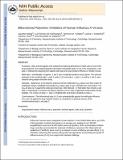| dc.contributor.author | Haldar, Jayanta | |
| dc.contributor.author | Alvarez de Cienfuegos, Luis | |
| dc.contributor.author | Tumpey, Terrence M. | |
| dc.contributor.author | Gubareva, Larisa V. | |
| dc.contributor.author | Chen, Jianzhu | |
| dc.contributor.author | Klibanov, Alexander M. | |
| dc.date.accessioned | 2012-09-20T19:24:03Z | |
| dc.date.available | 2012-09-20T19:24:03Z | |
| dc.date.issued | 2010-02 | |
| dc.date.submitted | 2009-09 | |
| dc.identifier.issn | 0724-8741 | |
| dc.identifier.issn | 1573-904X | |
| dc.identifier.uri | http://hdl.handle.net/1721.1/73085 | |
| dc.description.abstract | Purpose:
New antiviral agents were prepared by attaching derivatives of sialic acid (1) and of the drug zanamivir (2) to poly(isobutylene-alt-maleic anhydride) (poly-(1 + 2)) or by mixing poly-1 and poly-2, followed by assaying them against wild-type and drug-resistant influenza A Wuhan viruses.
Methods:
Individually or together, 1 and 2 were covalently bonded to the polymer. The antiviral potencies of the resultant poly-1, poly-2, poly-(1 + 2), and poly-1 + poly-2, as well as 1 and 2, were assessed using plaque reduction assay.
Results:
Attaching 1 to the polymer improved at best millimolar IC50 values over three orders of magnitude. While 2 exhibited micromolar IC50 values, poly-2 was >100-fold even more potent. The IC50 of poly-(1 + 2) against the wild-type strain was >300-fold and ∼17-fold better than of poly-1 and poly-2, respectively. In contrast, the potency of poly-(1 + 2) vs. poly-2 against the mutant strain merely doubled. The mixture of poly-1 + poly-2 inhibited both viral strains similarly to poly-2.
Conclusions:
The bifunctional poly-(1 + 2) acts synergistically against the wild-type influenza virus, but not against its drug-resistant mutant, as compared to a physical mixture of the monofunctional poly-1 and poly-2. | en_US |
| dc.description.sponsorship | National Institutes of Health (U.S.) (NIH grant U01-AI074443) | en_US |
| dc.description.sponsorship | Fundación Ramón Areces (postdoctoral fellowship) | en_US |
| dc.language.iso | en_US | |
| dc.publisher | Springer Science + Business Media B.V. | en_US |
| dc.relation.isversionof | http://dx.doi.org/10.1007/s11095-009-0013-1 | en_US |
| dc.rights | Creative Commons Attribution-Noncommercial-Share Alike 3.0 | en_US |
| dc.rights.uri | http://creativecommons.org/licenses/by-nc-sa/3.0/ | en_US |
| dc.source | PMC | en_US |
| dc.title | Bifunctional Polymeric Inhibitors of Human Influenza A Viruses | en_US |
| dc.type | Article | en_US |
| dc.identifier.citation | Haldar, Jayanta et al. “Bifunctional Polymeric Inhibitors of Human Influenza A Viruses.” Pharmaceutical Research 27.2 (2009): 259–263. Web. | en_US |
| dc.contributor.department | Massachusetts Institute of Technology. Department of Biological Engineering | en_US |
| dc.contributor.department | Massachusetts Institute of Technology. Department of Biology | en_US |
| dc.contributor.department | Massachusetts Institute of Technology. Department of Chemistry | en_US |
| dc.contributor.department | Koch Institute for Integrative Cancer Research at MIT | en_US |
| dc.contributor.mitauthor | Klibanov, Alexander M. | |
| dc.contributor.mitauthor | Alvarez de Cienfuegos, Luis | |
| dc.contributor.mitauthor | Chen, Jianzhu | |
| dc.relation.journal | Pharmaceutical Research | en_US |
| dc.eprint.version | Author's final manuscript | en_US |
| dc.type.uri | http://purl.org/eprint/type/JournalArticle | en_US |
| eprint.status | http://purl.org/eprint/status/PeerReviewed | en_US |
| dspace.orderedauthors | Haldar, Jayanta; Álvarez de Cienfuegos, Luis; Tumpey, Terrence M.; Gubareva, Larisa V.; Chen, Jianzhu; Klibanov, Alexander M. | en |
| dc.identifier.orcid | https://orcid.org/0000-0003-3830-714X | |
| dc.identifier.orcid | https://orcid.org/0000-0002-5687-6154 | |
| mit.license | OPEN_ACCESS_POLICY | en_US |
| mit.metadata.status | Complete | |
